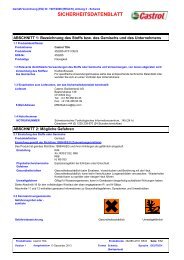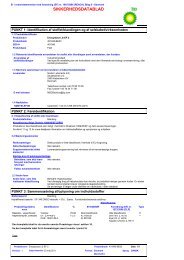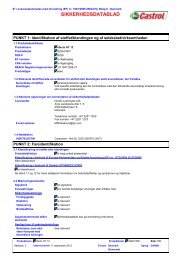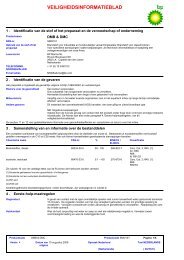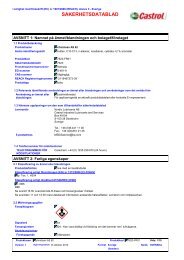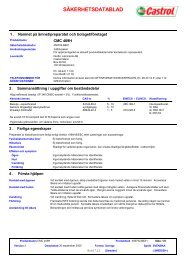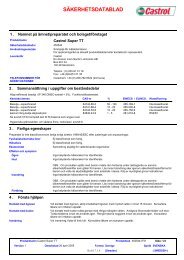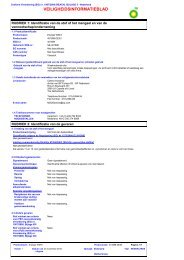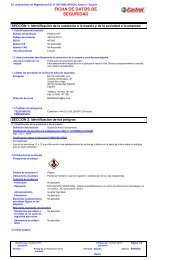219217Bartran HV 22.pdf - BP
219217Bartran HV 22.pdf - BP
219217Bartran HV 22.pdf - BP
You also want an ePaper? Increase the reach of your titles
YUMPU automatically turns print PDFs into web optimized ePapers that Google loves.
Conforms to Regulation (EC) No. 1907/2006 (REACH), Annex II - Sweden<br />
SAFETY DATA SHEET<br />
SECTION 1: Identification of the substance/mixture and of the company/undertaking<br />
1.1 Product identifier<br />
Product name<br />
Bartran <strong>HV</strong> 22<br />
Product code<br />
400886-BE02<br />
SDS no. 400886<br />
Product registration number Not applicable<br />
Product type<br />
Liquid.<br />
1.2 Relevant identified uses of the substance or mixture and uses advised against<br />
Use of the substance/<br />
mixture<br />
Hydraulic fluid<br />
For specific application advice see appropriate Technical Data Sheet or consult our company<br />
representative.<br />
1.3 Details of the supplier of the safety data sheet<br />
Supplier<br />
Nordic Lubricants AB<br />
Castrol Industrial Lubricants and Services<br />
Box 49104<br />
S-100 28 Stockholm<br />
Sweden<br />
E-mail address<br />
Tel.: +46 (0)8-441 11 00<br />
Fax.: +46 (0)8-651 01 35<br />
MSDSadvice@bp.com<br />
1.4 Emergency telephone number<br />
EMERGENCY<br />
TELEPHONE NUMBER<br />
SECTION 2: Hazards identification<br />
2.1 Classification of the substance or mixture<br />
Product definition<br />
Carechem:+44 (0) 1235 239 670 (24 hours)<br />
Mixture<br />
Classification according to Directive 1999/45/EC [DPD]<br />
The product is not classified as dangerous according to Directive 1999/45/EC and its amendments.<br />
See sections 11 and 12 for more detailed information on health effects and symptoms and environmental hazards.<br />
2.2 Label elements<br />
Risk phrases<br />
Safety phrases<br />
Supplemental label<br />
elements<br />
Special packaging requirements<br />
Containers to be fitted<br />
with child-resistant<br />
fastenings<br />
Tactile warning of danger<br />
This product is not classified according to EU legislation.<br />
Not applicable.<br />
Not applicable.<br />
Not applicable.<br />
Not applicable.<br />
2.3 Other hazards<br />
Other hazards which do<br />
not result in classification<br />
Defatting to the skin.<br />
Note: High Pressure Applications<br />
Injections through the skin resulting from contact with the product at high pressure constitute a<br />
major medical emergency.<br />
See 'Notes to physician' under First-Aid Measures, Section 4 of this Safety Data Sheet.<br />
Product name<br />
Version 2.03<br />
Bartran <strong>HV</strong> 22 Product code 400886-BE02 Page: 1/9<br />
Date of issue 19 July 2013 Format Sweden Language ENGLISH<br />
(Sweden)
Conforms to Regulation (EC) No. 1907/2006 (REACH), Annex II - Sweden<br />
SECTION 3: Composition/information on ingredients<br />
Substance/mixture<br />
Mixture<br />
Highly refined base oil (IP 346 DMSO extract < 3%).<br />
Product/ingredient<br />
name<br />
Identifiers %<br />
Proprietary performance additives.<br />
67/548/EEC<br />
Classification<br />
Regulation (EC) No.<br />
1272/2008 [CLP]<br />
Type<br />
Base oil - unspecified Varies 1 -
Conforms to Regulation (EC) No. 1907/2006 (REACH), Annex II - Sweden<br />
SECTION 5: Firefighting measures<br />
5.1 Extinguishing media<br />
Suitable extinguishing<br />
media<br />
Unsuitable extinguishing<br />
media<br />
In case of fire, use foam, dry chemical or carbon dioxide extinguisher or spray.<br />
Do not use water jet.<br />
5.2 Special hazards arising from the substance or mixture<br />
Hazards from the<br />
substance or mixture<br />
Hazardous combustion<br />
products<br />
In a fire or if heated, a pressure increase will occur and the container may burst.<br />
Combustion products may include the following:<br />
carbon oxides (CO, CO2) (carbon monoxide, carbon dioxide)<br />
5.3 Advice for firefighters<br />
Special precautions for<br />
fire-fighters<br />
Special protective<br />
equipment for fire-fighters<br />
SECTION 6: Accidental release measures<br />
No action shall be taken involving any personal risk or without suitable training. Promptly<br />
isolate the scene by removing all persons from the vicinity of the incident if there is a fire.<br />
Fire-fighters should wear appropriate protective equipment and self-contained breathing<br />
apparatus (SCBA) with a full face-piece operated in positive pressure mode. Clothing for firefighters<br />
(including helmets, protective boots and gloves) conforming to European standard EN<br />
469 will provide a basic level of protection for chemical incidents.<br />
6.1 Personal precautions, protective equipment and emergency procedures<br />
For non-emergency<br />
personnel<br />
For emergency responders<br />
No action shall be taken involving any personal risk or without suitable training. Evacuate<br />
surrounding areas. Keep unnecessary and unprotected personnel from entering. Do not touch<br />
or walk through spilt material. Floors may be slippery; use care to avoid falling. Put on<br />
appropriate personal protective equipment.<br />
If specialised clothing is required to deal with the spillage, take note of any information in<br />
Section 8 on suitable and unsuitable materials. See also the information in "For nonemergency<br />
personnel".<br />
6.2 Environmental<br />
precautions<br />
Avoid dispersal of spilt material and runoff and contact with soil, waterways, drains and sewers.<br />
Inform the relevant authorities if the product has caused environmental pollution (sewers,<br />
waterways, soil or air).<br />
6.3 Methods and materials for containment and cleaning up<br />
Small spill<br />
Large spill<br />
Stop leak if without risk. Move containers from spill area. Absorb with an inert material and<br />
place in an appropriate waste disposal container. Dispose of via a licensed waste disposal<br />
contractor.<br />
Immediately contact emergency personnel. Stop leak if without risk. Move containers from spill<br />
area. Prevent entry into sewers, water courses, basements or confined areas. Contain and<br />
collect spillage with non-combustible, absorbent material e.g. sand, earth, vermiculite or<br />
diatomaceous earth and place in container for disposal according to local regulations. Dispose<br />
of via a licensed waste disposal contractor.<br />
6.4 Reference to other<br />
sections<br />
SECTION 7: Handling and storage<br />
7.1 Precautions for safe handling<br />
Protective measures<br />
Advice on general<br />
occupational hygiene<br />
See Section 1 for emergency contact information.<br />
See Section 5 for firefighting measures.<br />
See Section 8 for information on appropriate personal protective equipment.<br />
See Section 12 for environmental precautions.<br />
See Section 13 for additional waste treatment information.<br />
Put on appropriate personal protective equipment.<br />
Eating, drinking and smoking should be prohibited in areas where this material is handled,<br />
stored and processed. Wash thoroughly after handling. Remove contaminated clothing and<br />
protective equipment before entering eating areas. See also Section 8 for additional<br />
information on hygiene measures.<br />
Product name<br />
Version 2.03<br />
Bartran <strong>HV</strong> 22 Product code 400886-BE02 Page: 3/9<br />
Date of issue 19 July 2013 Format Sweden Language ENGLISH<br />
(Sweden)
Conforms to Regulation (EC) No. 1907/2006 (REACH), Annex II - Sweden<br />
SECTION 7: Handling and storage<br />
7.2 Conditions for safe<br />
storage, including any<br />
incompatibilities<br />
Not suitable<br />
Store and use only in equipment/containers designed for use with this product. Keep away<br />
from heat and direct sunlight. Keep container tightly closed and sealed until ready for use.<br />
Containers that have been opened must be carefully resealed and kept upright to prevent<br />
leakage. Do not store in unlabelled containers. Store in accordance with local regulations.<br />
Store in a dry, cool and well-ventilated area, away from incompatible materials (see Section 10).<br />
Prolonged exposure to elevated temperature.<br />
7.3 Specific end use(s)<br />
Recommendations<br />
Product/ingredient name<br />
Recommended monitoring<br />
procedures<br />
See section 1.2 and Exposure scenarios in annex, if applicable.<br />
SECTION 8: Exposure controls/personal protection<br />
8.1 Control parameters<br />
Occupational exposure limits<br />
Exposure limit values<br />
Base oil - unspecified<br />
AFS 2005:17 (Sweden).<br />
STEL: 3 mg/m³ 15 minutes. Issued/Revised: 8/1996 Form: mist and fume<br />
TWA: 1 mg/m³ 8 hours. Issued/Revised: 8/1996 Form: mist and fume<br />
Distillates (petroleum), hydrotreated, light naphthenic AFS 2005:17 (Sweden).<br />
TWA: 1 mg/m³ 8 hours. Issued/Revised: 8/1996 Form: mist and fume<br />
STEL: 3 mg/m³ 15 minutes. Issued/Revised: 8/1996 Form: mist and fume<br />
Distillates (petroleum), hydrotreated heavy paraffinic AFS 2005:17 (Sweden).<br />
TWA: 1 mg/m³ 8 hours. Issued/Revised: 8/1996 Form: mist and fume<br />
STEL: 3 mg/m³ 15 minutes. Issued/Revised: 8/1996 Form: mist and fume<br />
Distillates (petroleum), solvent-dewaxed heavy<br />
paraffinic<br />
AFS 2005:17 (Sweden).<br />
STEL: 3 mg/m³ 15 minutes. Issued/Revised: 8/1996 Form: mist and fume<br />
TWA: 1 mg/m³ 8 hours. Issued/Revised: 8/1996 Form: mist and fume<br />
Whilst specific OELs for certain components may be shown in this section, other components may be present in any mist,<br />
vapour or dust produced. Therefore, the specific OELs may not be applicable to the product as a whole and are provided for<br />
guidance only.<br />
Derived No Effect Level<br />
No DNELs/DMELs available.<br />
Predicted No Effect Concentration<br />
No PNECs available<br />
If this product contains ingredients with exposure limits, personal, workplace atmosphere or<br />
biological monitoring may be required to determine the effectiveness of the ventilation or other<br />
control measures and/or the necessity to use respiratory protective equipment. Reference<br />
should be made to monitoring standards, such as the following: European Standard EN 689<br />
(Workplace atmospheres - Guidance for the assessment of exposure by inhalation to chemical<br />
agents for comparison with limit values and measurement strategy) European Standard EN<br />
14042 (Workplace atmospheres - Guide for the application and use of procedures for the<br />
assessment of exposure to chemical and biological agents) European Standard EN 482<br />
(Workplace atmospheres - General requirements for the performance of procedures for the<br />
measurement of chemical agents) Reference to national guidance documents for methods for<br />
the determination of hazardous substances will also be required.<br />
8.2 Exposure controls<br />
Appropriate engineering<br />
controls<br />
Individual protection measures<br />
Hygiene measures<br />
Respiratory protection<br />
Provide exhaust ventilation or other engineering controls to keep the airborne concentrations of<br />
vapours below their respective occupational exposure limits.<br />
All activities involving chemicals should be assessed for their risks to health, to ensure<br />
exposures are adequately controlled. Personal protective equipment should only be considered<br />
after other forms of control measures (e.g. engineering controls) have been suitably evaluated.<br />
Personal protective equipment should conform to appropriate standards, be suitable for use, be<br />
kept in good condition and properly maintained.<br />
Your supplier of personal protective equipment should be consulted for advice on selection and<br />
appropriate standards. For further information contact your national organisation for standards.<br />
The final choice of protective equipment will depend upon a risk assessment. It is important to<br />
ensure that all items of personal protective equipment are compatible.<br />
Wash hands, forearms and face thoroughly after handling chemical products, before eating,<br />
smoking and using the lavatory and at the end of the working period. Ensure that eyewash<br />
stations and safety showers are close to the workstation location.<br />
Product name<br />
Version 2.03<br />
Bartran <strong>HV</strong> 22 Product code 400886-BE02 Page: 4/9<br />
Date of issue 19 July 2013 Format Sweden Language ENGLISH<br />
(Sweden)
Conforms to Regulation (EC) No. 1907/2006 (REACH), Annex II - Sweden<br />
SECTION 8: Exposure controls/personal protection<br />
Eye/face protection<br />
Skin protection<br />
Hand protection<br />
Skin and body<br />
Environmental exposure<br />
controls<br />
Respiratory protective equipment is not normally required where there is adequate natural or<br />
local exhaust ventilation to control exposure.<br />
In case of insufficient ventilation, wear suitable respiratory equipment.<br />
The correct choice of respiratory protection depends upon the chemicals being handled, the<br />
conditions of work and use, and the condition of the respiratory equipment. Safety procedures<br />
should be developed for each intended application. Respiratory protection equipment should<br />
therefore be chosen in consultation with the supplier/manufacturer and with a full assessment<br />
of the working conditions.<br />
Safety glasses with side shields.<br />
SECTION 9: Physical and chemical properties<br />
9.1 Information on basic physical and chemical properties<br />
Appearance<br />
Odour<br />
pH<br />
Physical state<br />
Colour<br />
Odour threshold<br />
Melting point/freezing point<br />
Initial boiling point and boiling<br />
range<br />
Flash point<br />
Evaporation rate<br />
Vapour pressure<br />
Vapour density<br />
Relative density<br />
Auto-ignition temperature<br />
Wear protective gloves if prolonged or repeated contact is likely.<br />
Wear chemical resistant gloves.<br />
Recommended: Nitrile gloves.<br />
The correct choice of protective gloves depends upon the chemicals being handled, the<br />
conditions of work and use, and the condition of the gloves (even the best chemically resistant<br />
glove will break down after repeated chemical exposures). Most gloves provide only a short<br />
time of protection before they must be discarded and replaced. Because specific work<br />
environments and material handling practices vary, safety procedures should be developed for<br />
each intended application. Gloves should therefore be chosen in consultation with the supplier/<br />
manufacturer and with a full assessment of the working conditions.<br />
Use of protective clothing is good industrial practice.<br />
Personal protective equipment for the body should be selected based on the task being<br />
performed and the risks involved and should be approved by a specialist before handling this<br />
product.<br />
Cotton or polyester/cotton overalls will only provide protection against light superficial<br />
contamination that will not soak through to the skin. Overalls should be laundered on a regular<br />
basis. When the risk of skin exposure is high (e.g. when cleaning up spillages or if there is a<br />
risk of splashing) then chemical resistant aprons and/or impervious chemical suits and boots<br />
will be required.<br />
Emissions from ventilation or work process equipment should be checked to ensure they<br />
comply with the requirements of environmental protection legislation. In some cases, fume<br />
scrubbers, filters or engineering modifications to the process equipment will be necessary to<br />
reduce emissions to acceptable levels.<br />
Liquid.<br />
Amber.<br />
Oily.<br />
Not available.<br />
Not available.<br />
Not available.<br />
Not available.<br />
Pour point
Conforms to Regulation (EC) No. 1907/2006 (REACH), Annex II - Sweden<br />
SECTION 9: Physical and chemical properties<br />
Explosive properties<br />
Not available.<br />
Oxidising properties<br />
Not available.<br />
9.2 Other information<br />
No additional information.<br />
SECTION 10: Stability and reactivity<br />
10.1 Reactivity No specific test data available for this product. Refer to Conditions to avoid and Incompatible<br />
materials for additional information.<br />
10.2 Chemical stability<br />
The product is stable.<br />
10.3 Possibility of<br />
hazardous reactions<br />
Under normal conditions of storage and use, hazardous polymerisation will not occur.<br />
Under normal conditions of storage and use, hazardous reactions will not occur.<br />
10.4 Conditions to avoid Avoid all possible sources of ignition (spark or flame).<br />
10.5 Incompatible materials<br />
Reactive or incompatible with the following materials: oxidising materials.<br />
10.6 Hazardous<br />
decomposition products<br />
Under normal conditions of storage and use, hazardous decomposition products should not be<br />
produced.<br />
SECTION 11: Toxicological information<br />
11.1 Information on toxicological effects<br />
Information on the likely<br />
routes of exposure<br />
Potential acute health effects<br />
Inhalation<br />
Ingestion<br />
Skin contact<br />
Eye contact<br />
Potential chronic health effects<br />
General<br />
Carcinogenicity<br />
Mutagenicity<br />
Developmental effects<br />
Vapour inhalation under ambient conditions is not normally a problem due to low vapour<br />
pressure.<br />
No known significant effects or critical hazards.<br />
May cause skin dryness and irritation.<br />
No known significant effects or critical hazards.<br />
Symptoms related to the physical, chemical and toxicological characteristics<br />
Inhalation<br />
Ingestion<br />
Skin contact<br />
Eye contact<br />
Fertility effects<br />
Routes of entry anticipated: Dermal, Inhalation.<br />
No specific data.<br />
No specific data.<br />
Adverse symptoms may include the following:<br />
irritation<br />
dryness<br />
cracking<br />
No specific data.<br />
Delayed and immediate effects and also chronic effects from short and long term exposure<br />
Inhalation<br />
Ingestion<br />
Skin contact<br />
Eye contact<br />
Overexposure to the inhalation of airborne droplets or aerosols may cause irritation of the<br />
respiratory tract.<br />
Ingestion of large quantities may cause nausea and diarrhoea.<br />
Prolonged or repeated contact can defat the skin and lead to irritation and/or dermatitis.<br />
Potential risk of transient stinging or redness if accidental eye contact occurs.<br />
Prolonged or repeated contact can defat the skin and lead to irritation, cracking and/or<br />
dermatitis.<br />
No known significant effects or critical hazards.<br />
No known significant effects or critical hazards.<br />
No known significant effects or critical hazards.<br />
No known significant effects or critical hazards.<br />
Product name<br />
Version 2.03<br />
Bartran <strong>HV</strong> 22 Product code 400886-BE02 Page: 6/9<br />
Date of issue 19 July 2013 Format Sweden Language ENGLISH<br />
(Sweden)
Conforms to Regulation (EC) No. 1907/2006 (REACH), Annex II - Sweden<br />
SECTION 12: Ecological information<br />
12.1 Toxicity<br />
Environmental hazards<br />
Not classified as dangerous<br />
12.2 Persistence and degradability<br />
Expected to be biodegradable.<br />
12.3 Bioaccumulative potential<br />
This product is not expected to bioaccumulate through food chains in the environment.<br />
12.4 Mobility in soil<br />
Soil/water partition<br />
coefficient (KOC)<br />
Mobility<br />
Not available.<br />
Spillages may penetrate the soil causing ground water contamination.<br />
12.5 Results of PBT and vPvB assessment<br />
PBT<br />
Not applicable.<br />
vPvB<br />
Not applicable.<br />
12.6 Other adverse effects<br />
Other ecological information<br />
SECTION 13: Disposal considerations<br />
13.1 Waste treatment methods<br />
Product<br />
Methods of disposal<br />
Hazardous waste<br />
European waste catalogue (EWC)<br />
Packaging<br />
Waste code<br />
Spills may form a film on water surfaces causing physical damage to organisms. Oxygen<br />
transfer could also be impaired.<br />
The generation of waste should be avoided or minimised wherever possible. Significant<br />
quantities of waste product residues should not be disposed of via the foul sewer but processed<br />
in a suitable effluent treatment plant. Dispose of surplus and non-recyclable products via a<br />
licensed waste disposal contractor. Disposal of this product, solutions and any by-products<br />
should at all times comply with the requirements of environmental protection and waste disposal<br />
legislation and any regional local authority requirements.<br />
Yes.<br />
13 01 10* mineral based non-chlorinated hydraulic oils<br />
Methods of disposal<br />
Waste code<br />
Waste designation<br />
However, deviation from the intended use and/or the presence of any potential contaminants may require an alternative waste<br />
disposal code to be assigned by the end user.<br />
Dispose of via an authorised person/ licensed waste disposal contractor in accordance with<br />
local regulations. Recycle, if possible.<br />
European waste catalogue (EWC)<br />
15 01 10* packaging containing residues of or contaminated by dangerous substances<br />
Special precautions<br />
Methods of disposal<br />
This material and its container must be disposed of in a safe way. Empty containers or liners<br />
may retain some product residues. Empty containers represent a fire hazard as they may<br />
contain flammable product residues and vapour. Never weld, solder or braze empty containers.<br />
Avoid dispersal of spilt material and runoff and contact with soil, waterways, drains and sewers.<br />
The regulations regarding manufacturers' responsibility for packaging material waste is<br />
regulated in "Förordningen om producentansvar för förpackningar". Packaging materials are to<br />
be reused or recycled in accordance with the goals outlined in this regulation. The company<br />
complies with this manufacturer's responsibility through its association with REPA, which is a<br />
subsidiary company of four materials handling companies. The materials handling companies<br />
collect, remove and process used and sorted packaging materials through the employment of<br />
contractors. Questions regarding collection of packaging materials on a local basis may be<br />
directed to the materials company and its contractors. For further information, contact REPA,<br />
www.repa.se.<br />
Drums and containers are placed in a tilted position, approx 10°, drums are turned with the<br />
bungholes downwards and the 2’’ bunghole in the lowest position, containers with the valve<br />
downwards. Other packages are placed upside down for eduction. Let stand at temperatures<br />
above 15ºC until drip dry or at least 30 minutes. Recover and add the remainders in the process<br />
Product name<br />
Version 2.03<br />
Bartran <strong>HV</strong> 22 Product code 400886-BE02 Page: 7/9<br />
Date of issue 19 July 2013 Format Sweden Language ENGLISH<br />
(Sweden)
Conforms to Regulation (EC) No. 1907/2006 (REACH), Annex II - Sweden<br />
SECTION 13: Disposal considerations<br />
SECTION 14: Transport information<br />
where the product is used, or send for special waste treatment. Send empty packages to a<br />
certified recycler/receiver for recycling.<br />
ADR/RID ADN<br />
IMDG IATA<br />
14.1 UN number<br />
Not regulated.<br />
Not regulated.<br />
Not regulated.<br />
Not regulated.<br />
14.2 UN proper<br />
shipping name<br />
-<br />
-<br />
-<br />
-<br />
14.3 Transport<br />
hazard class(es)<br />
-<br />
-<br />
-<br />
-<br />
14.4 Packing<br />
group<br />
-<br />
-<br />
-<br />
-<br />
14.5<br />
Environmental<br />
hazards<br />
Additional<br />
information<br />
No. No. No. No.<br />
- - - -<br />
14.6 Special precautions for<br />
user<br />
Not available.<br />
SECTION 15: Regulatory information<br />
15.1 Safety, health and environmental regulations/legislation specific for the substance or mixture<br />
EU Regulation (EC) No. 1907/2006 (REACH)<br />
Annex XIV - List of substances subject to authorisation<br />
Substances of very high concern<br />
None of the components are listed.<br />
Annex XVII - Restrictions<br />
on the manufacture,<br />
placing on the market<br />
and use of certain<br />
dangerous substances,<br />
mixtures and articles<br />
Other regulations<br />
REACH Status<br />
United States inventory<br />
(TSCA 8b)<br />
Australia inventory (AICS)<br />
Canada inventory<br />
China inventory (IECSC)<br />
Japan inventory (ENCS)<br />
Korea inventory (KECI)<br />
Philippines inventory<br />
(PICCS)<br />
Not applicable.<br />
The company, as identified in Section 1, sells this product in the EU in compliance with the<br />
current requirements of REACH.<br />
All components are listed or exempted.<br />
All components are listed or exempted.<br />
All components are listed or exempted.<br />
All components are listed or exempted.<br />
All components are listed or exempted.<br />
All components are listed or exempted.<br />
All components are listed or exempted.<br />
15.2 Chemical Safety<br />
Assessment<br />
This product contains substances for which Chemical Safety Assessments are still required.<br />
Product name<br />
Version 2.03<br />
Bartran <strong>HV</strong> 22 Product code 400886-BE02 Page: 8/9<br />
Date of issue 19 July 2013 Format Sweden Language ENGLISH<br />
(Sweden)
Conforms to Regulation (EC) No. 1907/2006 (REACH), Annex II - Sweden<br />
SECTION 16: Other information<br />
Abbreviations and acronyms<br />
Full text of abbreviated H<br />
statements<br />
Full text of classifications<br />
[CLP/GHS]<br />
Full text of abbreviated R<br />
phrases<br />
Full text of classifications<br />
[DSD/DPD]<br />
History<br />
Date of issue/ Date of<br />
revision<br />
Date of previous issue<br />
Prepared by<br />
ADN = European Provisions concerning the International Carriage of Dangerous Goods by<br />
Inland Waterway<br />
ADR = The European Agreement concerning the International Carriage of Dangerous Goods by<br />
Road<br />
ATE = Acute Toxicity Estimate<br />
BCF = Bioconcentration Factor<br />
CAS = Chemical Abstracts Service<br />
CLP = Classification, Labelling and Packaging Regulation [Regulation (EC) No. 1272/2008]<br />
CSA = Chemical Safety Assessment<br />
CSR = Chemical Safety Report<br />
DMEL = Derived Minimal Effect Level<br />
DNEL = Derived No Effect Level<br />
DPD = Dangerous Preparations Directive [1999/45/EC]<br />
DSD = Dangerous Substances Directive [67/548/EEC]<br />
EINECS = European Inventory of Existing Commercial chemical Substances<br />
ES = Exposure Scenario<br />
EUH statement = CLP-specific Hazard statement<br />
EWC = European Waste Catalogue<br />
GHS = Globally Harmonized System of Classification and Labelling of Chemicals<br />
IATA = International Air Transport Association<br />
IBC = Intermediate Bulk Container<br />
IMDG = International Maritime Dangerous Goods<br />
LogPow = logarithm of the octanol/water partition coefficient<br />
MARPOL 73/78 = International Convention for the Prevention of Pollution From Ships, 1973 as<br />
modified by the Protocol of 1978. ("Marpol" = marine pollution)<br />
OECD = Organisation for Economic Co-operation and Development<br />
PBT = Persistent, Bioaccumulative and Toxic<br />
PNEC = Predicted No Effect Concentration<br />
RID = The Regulations concerning the International Carriage of Dangerous Goods by Rail<br />
RRN = REACH Registration Number<br />
SADT = Self-Accelerating Decomposition Temperature<br />
SVHC = Substances of Very High Concern<br />
STOT-RE = Specific Target Organ Toxicity - Repeated Exposure<br />
STOT-SE = Specific Target Organ Toxicity - Single Exposure<br />
TWA = Time weighted average<br />
UN = United Nations<br />
UVCB = Complex hydrocarbon substance<br />
VOC = Volatile Organic Compound<br />
vPvB = Very Persistent and Very Bioaccumulative<br />
H304<br />
Not applicable.<br />
Not applicable.<br />
May be fatal if swallowed and enters airways.<br />
Asp. Tox. 1, H304 ASPIRATION HAZARD - Category 1<br />
19/07/2013.<br />
26/04/2013.<br />
Product Stewardship<br />
Indicates information that has changed from previously issued version.<br />
Notice to reader<br />
All reasonably practicable steps have been taken to ensure this data sheet and the health, safety and environmental information<br />
contained in it is accurate as of the date specified below. No warranty or representation, express or implied is made as to the<br />
accuracy or completeness of the data and information in this data sheet.<br />
The data and advice given apply when the product is sold for the stated application or applications. You should not use the<br />
product other than for the stated application or applications without seeking advice from us.<br />
It is the user’s obligation to evaluate and use this product safely and to comply with all applicable laws and regulations. The <strong>BP</strong><br />
Group shall not be responsible for any damage or injury resulting from use, other than the stated product use of the material,<br />
from any failure to adhere to recommendations, or from any hazards inherent in the nature of the material. Purchasers of the<br />
product for supply to a third party for use at work, have a duty to take all necessary steps to ensure that any person handling or<br />
using the product is provided with the information in this sheet. Employers have a duty to tell employees and others who may be<br />
affected of any hazards described in this sheet and of any precautions that should be taken.<br />
Product name<br />
Version 2.03<br />
Bartran <strong>HV</strong> 22 Product code 400886-BE02 Page: 9/9<br />
Date of issue 19 July 2013 Format Sweden Language ENGLISH<br />
(Sweden)



